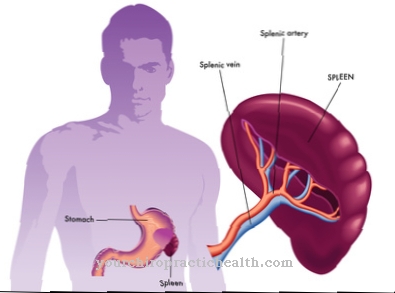Everyone has probably experienced a feeling of dizziness before: it seems as if the room is rotating or swaying around you. Dizziness can come in different forms and have many causes. The most common type in adults is Positional vertigo.
What is positional vertigo?

Benign paroxysmal positional vertigo (BPLS) is the most common form of vertigo in adults. All those affected complain of attacks of vertigo lasting around thirty seconds after a change in position, for example when lying down, turning the head or lifting and lowering the head.
Some patients also experience nausea and vomiting, as well as the feeling of walking on cotton. Despite these symptoms, positional vertigo is medically defined as uncomfortable and restrictive in everyday life, but not as pathological.
For this reason, clear studies on the frequency of this benign form of vertigo are still lacking. It is known that it increases in frequency between the ages of 60 and 80 and that women are more likely to be affected than men. Current figures from Germany and the USA suggest that there are 64 new cases per 100,000 inhabitants every year.
causes
The cause of benign paroxysmal positional vertigo lies in the inner ear and is quite complex. When the otoliths, which can be roughly described as sensory and equilibrium cells of the inner ear, detach themselves from the ear cavity and migrate into the semicircular canal, they move with every head tilt.
The brain then receives a motion report, which no other body organ can confirm, and reacts to the confusion with dizziness.
The reasons for which the otholites break away have not yet been adequately explained. Science suspects this process as a normal part of getting older. Head trauma, internal brain surgery and inflammation of the inner ear are risk factors for positional vertigo.
Positional dizziness is also common in migraineurs and those affected by Menière's disease. It can also occur with disorders of the brain functions.
You can find your medication here
➔ Medication for dizziness and circulatory problemsDiseases with this symptom
- concussion
- Transient ischemic attack
- Circulatory disorders
- migraine
- Meningitis
- travel sickness
- Inner ear infection
- Meniere's disease
- stroke
Diagnosis & course
Spontaneous healing occurs very often in the case of positional dizziness, so that a visit to the doctor is unnecessary. If the symptoms persist for a long time, an ear, nose and throat specialist should be consulted in order to rule out more serious causes and to initiate adequate therapy.
The doctor will first test the patient's hearing and balance to rule out sudden hearing loss and serious consequences and causes of dizziness. In a detailed anamnesis, all symptoms and the peculiarities of the vertigo that the patient notices are discussed in order to clearly diagnose the form of vertigo.
If, after the detailed diagnosis, it is suspected that the cause of the dizziness lies in the brain, the ear, nose and throat doctor will initiate further examinations. These include imaging tests, neurological examinations, and measurements of brain waves.
Often the positional dizziness disappears after a while, but long-lasting courses over months and years are also possible. In addition, more than two thirds of patients experience a recurrence of dizziness within two years.
Complications
Positional vertigo is a benign disease that can usually be cured with simple exercises. However, it happens again and again that the therapy takes a little longer. Then the symptoms of dizziness can reduce the quality of life of those affected. Many people find the dizziness attacks frightening. If the dizziness attacks occur very frequently, a high level of psychological distress develops.
The vertigo does not leave any permanent damage. In the long term, however, psychological problems can arise. Sometimes a fearful attitude develops before the next attack. Some patients need psychotherapeutic care to deal with the psychological consequences. Often there are also sleep disorders. These develop due to the fact that attacks of dizziness often occur during sleep.
This happens very often because the positional vertigo is always triggered by changes in the position of the body. There is often a change in position during sleep. Another complication is the possible occurrence of falls. This is particularly a problem for older patients, as these falls can easily lead to broken bones and other injuries with dangerous consequences.
In the elderly, dizziness can sometimes become an emergency. In addition, the risk of positional vertigo increases with age. But falls are also a major health risk for young people.
When should you go to the doctor?
Benign paroxysmal positional vertigo is a harmless phenomenon despite the often very threatening attacks of vertigo. In relation to the physique, no visit to the doctor is necessary because of this benign and usually self-decreasing form of vertigo. Nevertheless, there are cases in which a visit to a family doctor or an ENT doctor or neurologist makes perfect sense.
In this case, the first visit in the case of the occurrence of the dizziness comes first in terms of an exact diagnosis. In view of the violent attacks of dizziness, which can frighten the patient, especially the first time they appear, it often helps to reassure them that there is no stroke or other serious illness behind the pronounced symptoms. The one-time visit to the doctor has another advantage: The doctor can show the person concerned exercises with which the symptoms of dizziness can be eliminated through self-help.
Once the patient has learned the exercises that are helpful against positional vertigo, they no longer need to see a doctor because of the unpleasant but completely harmless clinical picture. However, there are a few exceptions: The doctor should be asked again for advice if the exercises do not help or if dizziness is accompanied by other symptoms such as headache and fainting. If you are very worried about the harmless dizziness, behavior therapy from a psychologist or psychotherapist can also help.
Doctors & therapists in your area
Treatment & Therapy
Despite the good prospect of spontaneous healing, positional vertigo should be treated. This is particularly necessary to counteract avoidance behavior on the part of the patient, as this can have functional consequences and prolong the duration of the suffering.
In addition, there is a chance of getting used to the, albeit unpleasant, targeted triggering of the symptoms, so that the brain loses its irritation and the symptoms recede.
The detachment of the othilia is not reversible. With appropriate movement and positioning exercises, however, if performed correctly, it should be possible to move the othilia out of the semicircular canals and into a harmless resting position. The most famous exercise is the Epley maneuver, the effectiveness of which has been proven in various independent studies.
Since it is important that this treatment is carried out under expert guidance in order to avoid complications, it is not described in detail here.
Medicines and surgical methods, such as the removal of the equilibrium organ, are not used in the case of positional dizziness, as they have excessive side effects.
Outlook & forecast
In the case of positional vertigo, a visit to the doctor is usually not necessary. In most cases, the symptom goes away on its own and does not require treatment. If the symptoms persist, however, the ENT doctor can be asked for advice.
It is not uncommon for the patient to suffer from positional dizziness as well as impaired hearing and vision. How severe these restrictions will be cannot be generally predicted. Often there is severe headache and nausea. With this symptom, spontaneous healing occurs in many cases. However, patients can suffer from positional vertigo for several years.
The patient's life is restricted by the positional vertigo. Often it is no longer possible to go to the workplace without further ado. In addition, there are sometimes insomnia or depression. Due to the positional vertigo, accidents with broken bones can occur more easily. The symptom also increases the risk of strokes and sudden fainting.
The symptom is usually not treated with medication or surgery. If the positional vertigo is triggered by certain processes, these must be avoided by the patient.
You can find your medication here
➔ Medication for dizziness and circulatory problemsprevention
There is no way to prevent positional vertigo. Avoiding appropriate head movements is also harmful, as it counteracts healing.
You can do that yourself
Posing vertigo feels extremely uncomfortable. Nevertheless, it is harmless in itself. However, anyone affected can counteract the sometimes massive attacks of dizziness with certain exercises. These also feel very uncomfortable at the beginning, because the person concerned triggers the dizziness he would like to avoid by precisely prescribed jerky movements. But there is no alternative to this. In acute attacks of dizziness, sitting still, conscious and slow head movements are indicated.
In mild cases of positional vertigo, it may be sufficient to make conscious and significantly slower movements with the head. Occasionally, the positional vertigo subsides after a few days. Since the positional vertigo can occur more frequently with increasing age, those affected should develop helpful strategies in good time. This enables them to respond better to the first occurrence of a new attack of positional vertigo.
Counter-strategies like the Epley maneuver are, from a medical point of view, the only remedy that is helpful against positional vertigo. The exercises against positional dizziness that can be found on the Internet can be internalized and practiced when positional dizziness first occurs. In addition, patients also have the option of using acupressure points, hand or foot reflexology massages or the Dorn method to provide relief. These are measures that anyone affected can try out in the event of acute vertigo attacks. Whether they are helpful varies from person to person.



























